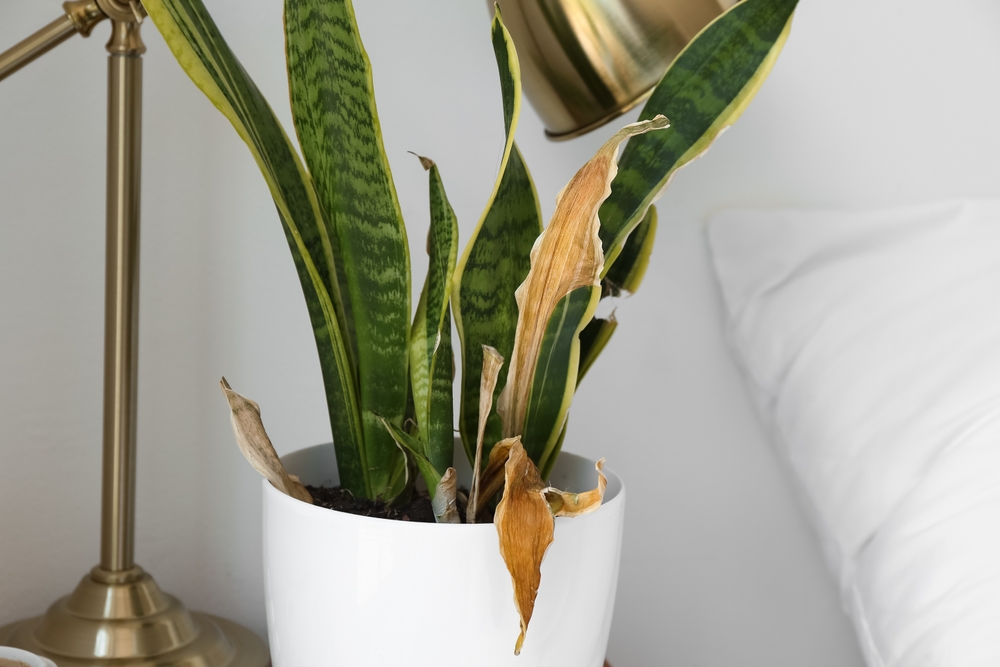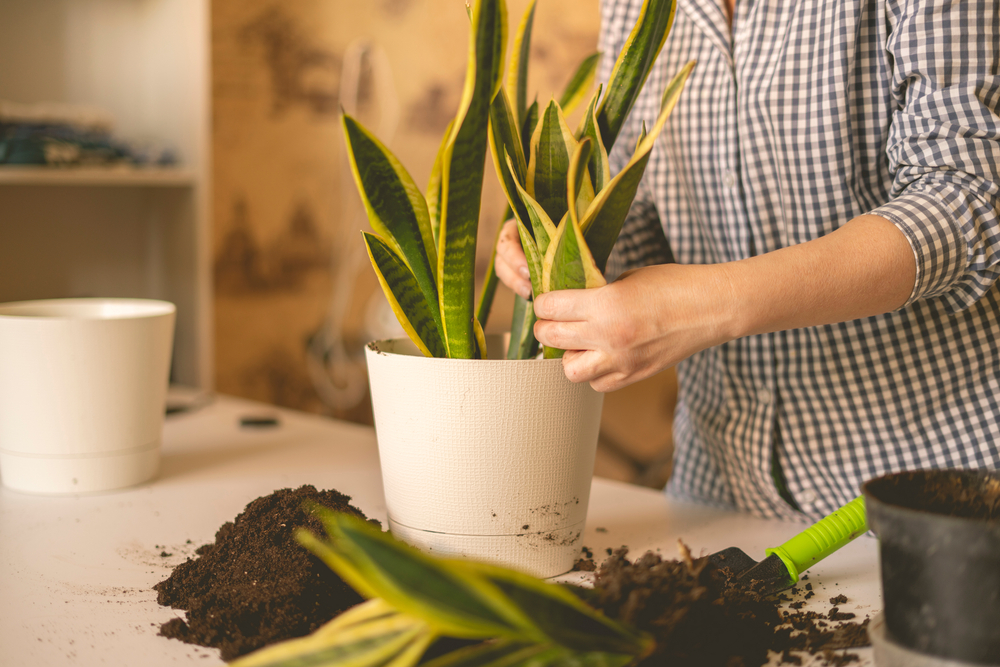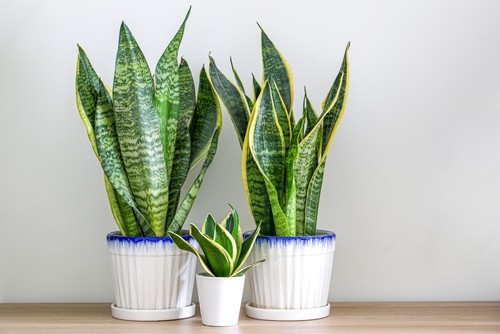Snake plants are a popular choice for indoor plants due to their hardy nature and low maintenance requirements. However, it can be concerning when the leaves start turning brown.
Brown leaves can be a sign of various issues, ranging from overwatering to insect infestations. In this article, we will explore the common causes of browning in snake plants and provide tips on how to fix and prevent the issue.
Understanding snake plants is essential to identify the cause of browning. Snake plants, also known as Sansevieria, are native to Africa and Asia and are known for their long, upright leaves that grow in a rosette pattern.
They are drought-tolerant and prefer well-draining soil. Snake plants can thrive in a range of lighting conditions, from low to bright light. However, they are sensitive to overwatering and can suffer from root rot if the soil is too wet for too long.
Signs and symptoms of browning in snake plants can vary depending on the cause. Overwatering can cause the leaves to turn soft and mushy, while underwatering can cause the leaves to turn brown and crispy. Insect infestations can cause brown spots or holes in the leaves.
By understanding the common causes of browning and the signs and symptoms to look out for, you can take the necessary steps to fix and prevent the issue.
Key Takeaways on My Snake Plant is Turning Brown
- Snake plants are hardy indoor plants, but brown leaves can be a sign of various issues.
- Understanding snake plants and their needs is essential to identify the cause of browning.
- Signs and symptoms of browning can vary depending on the cause, but by taking the necessary steps, you can fix and prevent the issue.
Check out why your other favorite houseplants are turning brown & best tips to fix it here:
Understanding Snake Plants

Snake plants, also known as Sansevieria or Dracaena trifasciata, are a popular choice for houseplants due to their resilience and ease of care. They are native to West Africa and are known for their long, upright leaves that can grow up to several feet tall.
Snake plants are often recommended for beginners because they are incredibly tolerant of neglect and can thrive in a variety of lighting conditions. They are also known to purify the air, making them a great addition to any home or office.
One of the unique features of snake plants is their ability to store water in their leaves, which allows them to survive in dry conditions. This means that overwatering can be a common problem for snake plants, as it can lead to root rot and other issues.
In terms of lighting, snake plants prefer bright, indirect light but can also tolerate low light conditions. However, if they are exposed to too much direct sunlight, their leaves can become scorched and turn brown.
My Snake Plant is Turning Brown – 7 Common Problems
Snake plants are known for their hardiness and ability to thrive in a variety of environments. However, even the most well-cared-for snake plant can develop brown leaves or brown spots. There are several common causes of browning in snake plants, including:
1. Overwatering
Overwatering is the most common cause of brown leaves in snake plants. When a snake plant is overwatered, the soil becomes waterlogged, which can lead to root rot. As a result, the leaves will turn brown and soft. To prevent overwatering, make sure to allow the soil to dry out completely between waterings.
2. Underwatering
On the other hand, if a snake plant is underwatered, the leaves will also turn brown and dry. To prevent underwatering, make sure to water the plant thoroughly and consistently.
3. Pests

Pests such as mealybugs and spider mites can cause brown spots on snake plant leaves. These pests feed on the plant’s sap, which can lead to brown, mushy leaves. To prevent pest infestations, check the plant regularly for signs of pests and treat with an appropriate insecticide if necessary.
4. Light
Snake plants thrive in indirect sunlight, but too much direct sunlight can cause the leaves to turn brown and wilt. To prevent sunburn, make sure to place the plant in a location with bright, indirect light.
5. Fertilizer
Overfertilization or fertilizer burn can cause brown tips or edges on snake plant leaves. To prevent fertilizer burn, make sure to follow the instructions on the fertilizer package and avoid overfertilizing.
6. Humidity
Snake plants prefer moderate to high humidity levels. If the air is too dry, the leaves may turn brown and curl. To increase humidity, consider using a humidifier or placing a tray of water near the plant.
7. Disease
Fungal diseases such as rust or decay can cause brown spots or patches on snake plant leaves. To prevent fungal diseases, make sure to provide proper air circulation and avoid overwatering. If the plant is already infected, treat with a fungicide.
By understanding the common causes of browning in snake plants, you can take steps to prevent and treat the issue, ensuring your plant stays healthy and vibrant.
Signs and Symptoms
Snake plants are known for their hardiness and ability to thrive in a variety of conditions. However, they are not immune to problems, and one of the most common issues that snake plant owners face is browning of the leaves.
When a snake plant is turning brown, it is a sign that something is wrong. The brown color can appear as spots or patches on the leaves, or it can cover the entire leaf. In some cases, the leaves may also start to yellow, droop, or curl.
The texture of the leaves can also change when a snake plant is turning brown. They may become soft, mushy, or even slimy to the touch. This is a sign that the plant is suffering from some kind of stress or disease.
There are many possible causes of snake plant leaves turning brown. One of the most common is overwatering. When a snake plant is watered too frequently or the soil is not well-draining, the roots can become waterlogged, which can lead to root rot. This, in turn, can cause the leaves to turn brown and mushy.
Another possible cause of snake plant leaves turning brown is exposure to direct sunlight. While snake plants do need some light to grow, too much direct sunlight can cause the leaves to dry out and turn brown. Similarly, exposure to cold temperatures or drafts can also cause stress to the plant and lead to browning of the leaves.
Pests can also be a culprit when it comes to snake plant leaves turning brown. Spider mites, mealybugs, and scale insects can all cause damage to the leaves, which can lead to browning and other symptoms.
How to Fix Browning Snake Plants

Snake plants are a hardy and resilient indoor plant that can withstand a variety of environmental conditions. However, even these tough plants can develop brown leaves and other issues if not cared for properly. Here are some tips for fixing browning snake plants:
1. Watering
Overwatering and underwatering are common causes of browning snake plants. If the soil is consistently wet or dry, it can stress the plant and cause the leaves to turn brown. To fix this issue, adjust the watering schedule to ensure that the soil is moist but not waterlogged.
If the plant is overwatered, consider repotting it in fresh soil with proper drainage holes. If the plant is underwatered, give it a thorough watering and monitor the soil to ensure that it stays moist.
2. Light and Sunlight
Snake plants prefer bright, indirect light, but can also tolerate low light conditions. However, too much direct sunlight can cause the leaves to turn brown and even burn. If the plant is in direct sunlight, move it to a shadier spot.
3. Fertilizer
Overfertilization or fertilizer burn can cause brown spots on snake plant leaves. To fix this issue, reduce the frequency of fertilizing and ensure that the plant is not receiving too much nutrients.
4. Soil and Roots
Improper soil or root conditions can also cause browning snake plants. Ensure that the plant is in well-draining soil and that the roots are not sitting in water. Consider repotting the plant in fresh soil if necessary.
5. Pests and Diseases
Fungal diseases and pests like spider mites can also cause brown spots on snake plant leaves. To fix this issue, use a fungicide or neem oil to eliminate the problem. If the plant is severely infested, consider propagating healthy leaves to start a new plant.
By following these tips, you can fix browning snake plants and ensure that they thrive in their indoor environment.
Prevention Tips for Healthy Snake Plants

Snake plants are low-maintenance plants that can thrive in a variety of conditions. However, to keep your snake plant healthy and vibrant, it is important to follow some basic care guidelines.
1. Watering
Overwatering is one of the most common causes of snake plant problems. To avoid this, make sure to water your snake plant only when the soil has completely dried out.
This can be determined by sticking your finger into the soil about an inch deep. If it feels dry, it’s time to water. It is also important to ensure that the pot has proper drainage to prevent the soil from becoming waterlogged.
2. Light
Snake plants can tolerate a range of light conditions, from low to bright indirect light. However, direct sunlight can scorch the leaves and cause them to turn brown.
To prevent this, place your snake plant in a location with bright, indirect light. If you want to place your snake plant in a window, make sure to use a sheer curtain to filter the direct sunlight.
3. Soil
Snake plants prefer well-draining soil that is slightly acidic. To ensure that your snake plant has the right soil, use a potting mix that is specifically designed for succulents. This type of soil will provide the proper drainage and nutrients that your snake plant needs to thrive.
4. Fertilizer
Snake plants do not require frequent fertilization. In fact, too much fertilizer can harm the plant. To keep your snake plant healthy, fertilize it once every two to three months during the growing season (spring and summer) with a balanced, water-soluble fertilizer.
Make sure to dilute the fertilizer to half the recommended strength to avoid burning the roots.
5. Humidity

Snake plants do not require high humidity levels to thrive. However, if you live in a dry climate, you can increase the humidity around your snake plant by placing a tray of pebbles and water beneath the pot. This will help to create a microclimate that is more humid.
By following these basic care guidelines, you can prevent your snake plant from turning brown and keep it healthy and vibrant for years to come.
Frequently Asked Questions
How do you fix brown leaves on a snake plant?
Brown leaves on a snake plant can be fixed by identifying the underlying problem. This can be caused by a variety of factors such as overwatering, underwatering, pests, or too much sunlight.
Once the problem is identified, corrective measures can be taken. For example, if the plant is overwatered, allow the soil to dry out before watering again. If pests are present, use an appropriate insecticide to eliminate them.
Should I cut the brown leaves off my snake plant?
Yes, cutting off the brown leaves on a snake plant is recommended. It helps the plant to conserve energy and focus on producing new leaves. Use sharp, clean scissors to cut the leaves as close to the base as possible without damaging the healthy leaves.
What does it mean when your snake plant is turning brown?
When a snake plant is turning brown, it is an indication of stress. The plant may be exposed to too much direct sunlight, low humidity, or incorrect watering.
It could also be due to pest infestations or nutrient deficiencies. Identifying the cause of the stress and taking corrective measures can help to restore the plant’s health.
What does overwatering a snake plant look like?
Overwatering a snake plant can cause the leaves to turn brown and mushy. The soil may also be waterlogged, and the plant may show signs of root rot. If the leaves are mushy and the soil is wet, it is an indication that the plant is overwatered.
Why are my snake plant leaves turning yellow?
Snake plant leaves turning yellow could be due to overwatering, underwatering, or nutrient deficiencies. The plant may also be exposed to too much direct sunlight or low humidity. Identifying the underlying problem and taking corrective measures can help to restore the plant’s health.
How often should I water my snake plant?
Snake plants are drought-tolerant and do not require frequent watering. It is recommended to water the plant once every two to three weeks or when the soil is dry to the touch. Overwatering can cause the plant to become stressed and develop brown leaves.

Hey, I’m Lisa and I’ve been an avid gardener for over 30 years. I love writing, talking and living in the garden! Feel free to connect with me on my socials below


